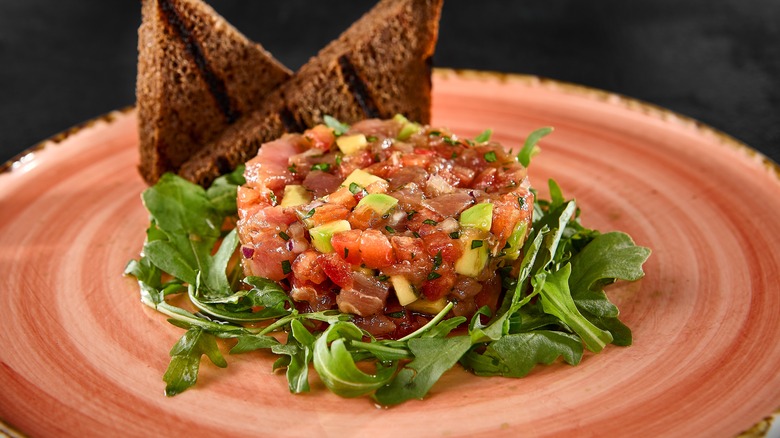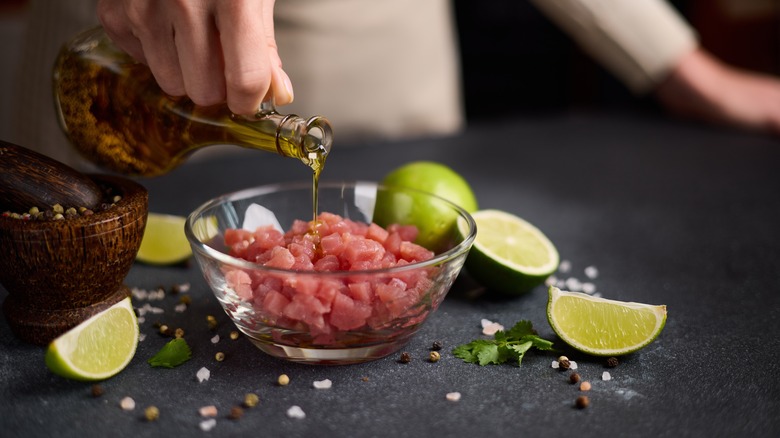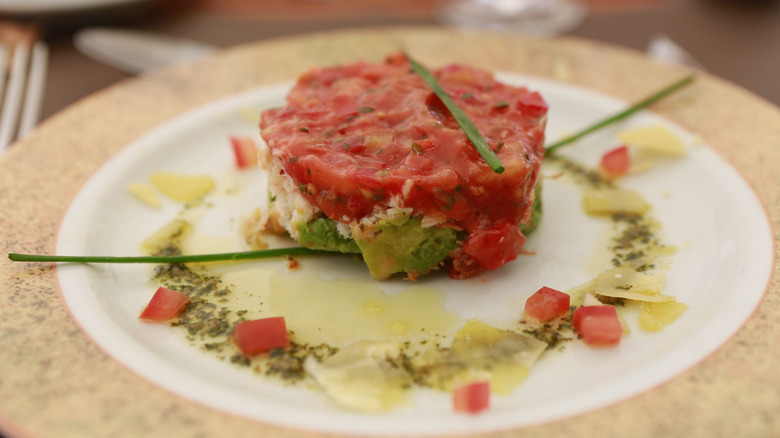How Tuna Tartare Went From A Last Minute Substitute To Prestige Appetizer
These days, tuna tartare is a dish you'd typically expect to find at a high-end, fine dining restaurant, especially restaurants specializing in asian fusion food. The dish, which is comprised of finely-chopped raw tuna and various add-ins depending on who is making it, has come to be seen as one of the most prestigious appetizers in the culinary sphere, but nobody could have predicted that when the dish was first invented. Unlike most foods, which have such long histories that their origins cannot truly be determined, we know where, when, and by whom tuna tartare was invented.
Remarkably, the dish has only been around for less than half a century. Its inventor is still alive and active in the restaurant business, and if you could travel back to that fateful day and tell him how popular tuna tartare is today, he'd probably laugh you off. That's because chef Shigefumi Tachibe, the man behind this legendary appetizer, only invented it as a last-minute solution to a request made by choosy customers. It proved so popular that it was added to the everyday menu. Restaurants around the country started making their own copycats. This launched a tartare trend that is still very much alive to this day, and the dish seems poised to be among the most prestigious appetizers long into the future.
Tuna tartare was invented as a substitute for beef
Tuna tartare was first served in 1984, but its history actually begins much earlier, with the invention of steak tartare. It is unclear exactly when and where steak tartare originated. A popular legend ascribes its invention to the Mongol warriors of Genghis Khan, known as Tartars, who purportedly used raw horse meat as a staple food, but the evidence for this story is lacking. The modern version emerged in France, with one of the earliest recipes being published by renowned chef Auguste Escoffier in 1921. From there, steak tartare became a restaurant staple, and raw beef became the foundation of many popular dishes, notably the cannibal sandwich.
Shigefumi Tachibe invented tuna tartare as a substitute for beef tartare. In 1984, he was a chef at Chaya Brasserie in Los Angeles, which served a prix-fixe menu with steak tartare as an appetizer. One day, a group of customers asked if the steak tartare could be substituted for something lighter (this was at the dawn of the low-fat craze). Tachibe searched his kitchen for a substitute, and realized that the dark red tuna he had on hand looked similar to beef. He swapped the fish into the dish, and the customers loved it so much they insisted he add it to the regular menu. Today, the knife Tachibe used to make the first tuna tartare is displayed in the Smithsonian Museum because what happened on that fateful night changed America's culinary landscape forever.
Tuna tartare's rise to fame
Tuna tartare rose to prominence in an environment of culinary innovation. At the time, many American customers were put off by dishes with heavy ingredients like red meat, butter, and cream. Shigefumi Tachibe also recognized that the hot climate of Los Angeles favored lighter dishes. The 1980s were a revolutionary time in the California restaurant industry as a whole. Fusion food emerged on the scene, largely thanks to chef Wolfgang Puck, who built a name for himself by blending European culinary traditions with East Asian influences and locally-sourced ingredients. Suddenly, eating raw fish wasn't such a novelty, and the environment was ripe for tuna tartare to take off.
At Chaya Brasserie, Tachibe made tuna tartare into a star, and inevitably, other chefs wanted in on the trend. Puck was foremost among them, making tuna tartare one of the signature dishes at his most famous restaurant, Spago. The base ingredient is always the same: raw tuna chopped finely, though not quite as fine as tuna scrape. What you mix that tuna with is optional, and different chefs have their own unique takes. If you want to stay true to the original, though, choose Tachibe's preferred tuna, ahi, and mix with egg yolks, Dijon mustard, pickles, onions, capers, tarragon, and green peppercorns.


